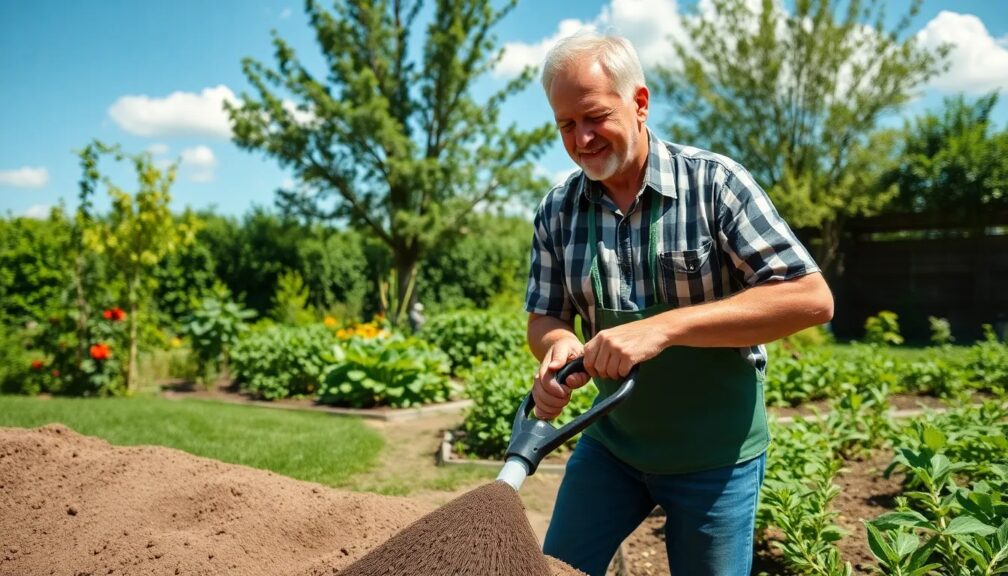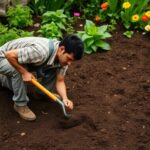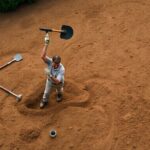How do you loosen compacted soil without tilling

Welcome to our in-depth guide on loosening compacted soil without tilling. Whether you're an avid gardener facing the challenge of hard, unyielding earth, or a homeowner looking to improve your lawn's health, compacted soil can be a formidable obstacle. Traditional tilling can disrupt soil structure and harm beneficial microorganisms, so many gardeners seek alternative methods. In this article, we'll explore effective strategies for enhancing soil aeration and structure, thereby promoting healthy plant growth. From the use of organic matter to the implementation of ground covers and aeration techniques, we'll guide you through several ways to revitalize your soil—no tilling required.
How do you loosen extremely compacted soil?
Transforming your garden from a barren plot to a fertile oasis hinges on one crucial secret: mastering the art of revitalizing compacted soil. Picture yourself slicing into the earth with ease, planting robust seeds that sprout into lush vegetation. It's not just a dream – it's within reach. The key is understanding the techniques to break up and aerate the hard-packed ground beneath your feet.
First, envision wielding a broadfork or garden fork, instruments that are essential in this quest. These tools become extensions of your hands as you pierce the soil, gently rocking back and forth to create fissures and air pockets. This method does more than just scratch the surface; it initiates a transformation that invites essential microorganisms and nutrients to awaken and thrive.
But the journey doesn't end there. Organic matter, such as compost or aged manure, acts as a catalyst in this revival. By integrating this material into the soil, you are not just loosening it, but also enriching it. As you mix and meld, a once inhospitable ground metamorphoses into a bed of fertility.
Imagine the enticement of water conservation too. Loosened soil improves drainage yet retains moisture, creating an environment where water is used efficiently, and your plants' roots can delve deep, unimpeded by the clutches of compacted earth.
Curiosity piqued? The full revelation of cultivating a vibrant garden from hardened soil awaits. The power to transform the ground is at your fingertips, and the lush, verdant garden of your dreams is just a few steps away. Discover the full scope of techniques and watch the magic happen right before your eyes. Your garden's potential is limitless, and the secret to unlocking it is here for the taking.
What can penetrate soil quickly and soften it?
Uncover the secret agents of gardening, the unsung heroes that delve deep into the earth, transforming stubborn terrain into a fertile sanctuary. These are not mere tools or simple techniques, but powerful elements that work their magic beneath the surface, often unnoticed by the naked eye. Imagine the potential of your garden as these forces work in harmony to create the perfect environment for growth.
Firstly, consider the natural wonder of water—a clear, vital liquid with the power to permeate even the toughest ground. It's more than just a thirst quencher for your plants; water is the elixir that softens soil, making way for roots to spread and nutrients to circulate.
Next in line is the transformative ability of organic matter. Materials like compost, leaves, and manure are not only eco-friendly but also packed with life-giving nutrients. When integrated into the soil, these substances break down, drawing in microorganisms that further enhance soil texture and fertility.
But have you ever heard of the silent, squirming cultivators known as earthworms? These creatures are nature's plows, tirelessly tunneling through the dirt. Their presence signifies a healthy soil ecosystem, as they aerate the earth and leave behind rich castings that benefit plant growth.
Finally, there exists a technique so simple yet often overlooked—aeration. By creating small holes in the soil, you invite air, water, and nutrients to penetrate deeper, encouraging robust root systems and overall soil health.
The pursuit of soft, penetrable soil may seem like a daunting quest, but it's a journey filled with intrigue and reward. Each component plays a pivotal role in transforming your garden into a verdant paradise. Stay tuned, as the exploration of these elements will reveal tips and tricks that can revolutionize the way you interact with the very ground beneath your feet.
What is the best way to soften hard soil?
Transforming hard soil into a plant-friendly haven is a game changer for any garden enthusiast. Imagine missing out on the secret techniques that could elevate your garden from barren to bountiful. The truth is, many gardeners struggle with tough, unyielding earth, but only a few know the tricks to effectively turn it around.
The first step in this transformative process is to introduce organic matter. This can come from compost, decayed leaves, or well-rotted manure, and it's vital for improving soil structure and fertility. But wait, there's a method to this madness. Simply scattering organic material on the surface won't cut it. You need to know the precise way to integrate it into the soil to reap the benefits.
Water management is another crucial element. Too little and the soil remains desiccated, too much and you risk compaction. The balance is key and we're here to reveal how to achieve it.
Don't even get us started on the benefits of aeration. This process can be a game-changer, allowing roots to breathe and moisture to penetrate. The techniques vary from simple tools to more complex machinery, but we know the most effective ways to aerate that stubborn soil.
And there's so much more. What about the role of pH balances and adjusting it to suit your plant's needs? Or the trick to using cover crops to naturally enhance soil quality during off-seasons? If you're not tapping into these strategies, you're not optimizing your garden's potential.
The quest for softer soil is filled with pitfalls and shortcuts, and we've navigated them all. Stay tuned as we delve deeper into the methods that will not just soften your hard soil, but turn your gardening efforts into the envy of the neighborhood. You don't want to miss out on these green-thumb secrets.
How to loosen soil without digging?
Unlock the secrets to revitalizing your garden's soil structure without the back-breaking labor of digging. Imagine transforming your compacted dirt into a rich, fluffy haven for your plants, with methods that are not only simple but also environmentally friendly.
First on the list is the magic of organic matter. By adding compost, you're not just enriching your soil with nutrients; you're also inviting a host of beneficial organisms to do the heavy lifting for you. Earthworms, for instance, are nature's little ploughs, and their tunneling actions naturally aerate the soil.
Have you heard of cover crops? These are not just for large-scale farmers. Sowing plants like clover or ryegrass can protect against erosion, and when chopped down and left on the surface, they become green manure that decomposes and improves soil structure.
Don't overlook the power of mulching. A layer of organic material spread over your soil can conserve moisture, suppress weeds, and as it breaks down, it continues to feed the soil, promoting increased porosity and better drainage.
For those who are truly invested in their garden's future, the concept of no-till gardening might be the next big step. This practice not only preserves the existing soil ecosystem but also builds upon it with each passing season, leading to a more vibrant and resilient garden.
Are you ready to dive into the details of each method and witness your garden thrive? Stay tuned, as these tips could revolutionize your gardening experience, making it more productive and far less labor-intensive. Your garden transformation awaits!
How to fix compacted soil in lawn
Has your once lush and vibrant lawn turned dull and lifeless? The culprit could very well be compacted soil, an issue that suffocates your grass roots and stunts growth. But fear not, for revitalizing your lawn is within reach, and the secret lies in the techniques that follow. Not only will these steps help you breathe life back into your grass, but they'll also prepare your garden to be the envy of the neighborhood.
First, let's talk about aeration. This is the process of punching holes into the soil to allow air, water, and nutrients to penetrate the ground. Aeration can be done manually with a fork for small areas or with a mechanical aerator for larger lawns. The best part? It's like giving your lawn a deep breath of fresh air!
Next up is top-dressing. This involves spreading a thin layer of organic material over the lawn. It can be compost, loam, or peat moss. This enriching layer works in tandem with aeration, filling the holes and introducing beneficial microorganisms.
But wait, there's more! Consider implementing a regular maintenance schedule. Over time, foot traffic and environmental factors continue to compact the soil, so regular aeration and top-dressing should become a cornerstone of your lawn care routine.
Now, let's talk about the magic of deep-rooted plants. Incorporating these into your lawn area can naturally break up compacted layers. The roots of these plants dig deep and break up the soil, improving its structure.
Still with me? Good, because here's a kicker: What if I told you that there's a timing secret to fixing compacted soil that amplifies results exponentially? Yes, timing plays a crucial role, and knowing exactly when to aerate and top-dress can make all the difference.
To uncover these secrets and transform your garden into a verdant paradise, stay tuned. Your dream lawn is just a few steps away, and I'm here to guide you through each one. Don't let compacted soil be the end of your green oasis. With a little effort and some insider knowledge, you'll soon master the art of lawn rejuvenation.
Consejo final: For those interested in loosening compacted soil without tilling, remember that patience and persistence are key. Employ methods such as mulching, adding organic matter, and deep root aeration to gradually improve soil structure. Over time, these practices will enhance soil health and foster better plant growth.
Take care and best of luck with your gardening endeavors!
 How do I fix hard soil in my garden
How do I fix hard soil in my garden How do you break up hard compacted clay soil
How do you break up hard compacted clay soil Should you pack down soil when planting
Should you pack down soil when planting What is the best tool for breaking up clay soil
What is the best tool for breaking up clay soil Does wetting soil make it easier to dig
Does wetting soil make it easier to digIf you want to know more about similar articles like How do you loosen compacted soil without tilling you can visit category Gardening Tools.
Deja una respuesta